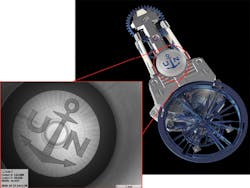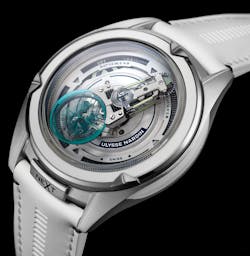Precision laser microfabrication creates novel 3D timepieces
Technology produces 3D components in glass
GIULIA BOTTARINI
Glass has unique properties and advantages compared to materials such as metals and polymers, as it is optically transparent, resistant to thermal shocks, abrasion, and scratches, biocompatible by nature, chemically stable, and electrically insulating. What is less evident, however, is that it has good elasticity properties and a high failure strength after chemical treatment.
Glass has therefore become a widespread material in horology (the study and management of time) and fine mechanics, whereas its tribological behavior, combined with three-dimensional (3D) structuring capabilities, have persuaded leading brands of the Fondation de la Haute Horlogerie to adopt FEMTOprint’s microfabrication platform to produce novel watch movements, dials, actuators, balance wheels, and time indicators.
Ulysse Nardin, a luxury Swiss watch manufacturer, has been pioneering watchmaking since its foundation in 1846. After a splash in 2017 with the release of the InnoVision Two timepiece, a concept watch that caught the attention of enthusiasts for its self-winding mechanism, oscillator, 3D glass minute hand, and glass bridge with integrated shock protection for the balance wheel, the watchmaker has now launched its FREAK neXt watch. This prototype watch, aiming at showcasing Ulysse Nardin’s technological milestone and FEMTOprint’s laser microfabrication expertise in glass, unveils a new flying carousel baguette movement equipped with a 3D-flying oscillator.
Microfabricated components
The FREAK neXt watch’s flying oscillator is based on flexible mechanisms using the elasticity of silicium blades, eliminating the central pivot so that the oscillator is suspended in mid-air. The primary idea of this regulating organ is to completely omit the axis of the balance wheel to create a virtual pivot point, removing friction on the bearings to optimize the global quality factor and therefore the movement’s energy consumption. This development improves upon the traditional principle of balance spring regulation that was introduced in the 17th century.
Toying with the limits of the physics of materials, the unlimited design freedom, and the unconventional surface smoothness and shape accuracy given by laser technology, the FREAK neXt watch presents the glass bridge of the baguette movement (the finishing gear train) with a slightly trapezoidal shape inspired by the spaceships from Star Wars. It is framed by four luminescent and transparent glass tubes (FIGURE 1), each being 400 µm in diameter (with inlets of 200 µm) and 8.34 mm in length, filled with Super-LumiNova, a strontium aluminate-based, nonradioactive, and nontoxic photoluminescent pigment.
The phosphorescence effect given by the pigment is visible only at night. The tubes are then superposed in a monolithic set of two and suspended on the baguette with a precision of a few microns. Excavating the material from the tubes, without compromising their shape accuracy and transparency, has been a major focus during manufacturing.The light generated by the pigments is then enhancing Ulysse Nardin’s logo, revealed in its characteristic marine blue (FIGURE 2) and engraved in the glass lens, to complete the decoration of the baguette movement. This central piece, which measures 5.0 mm in diameter and 1.95 mm high, exposes all the main challenges of fabricating 3D and monolithic structures in glass: multiple heights (from the lens contour to the trenched logo at the surface, 130–180 µm deep in the volume), planar and convex shapes with different angles and radius, paintings for decorations, and selective surface polishing, combined with tight requirements in the range of a few microns in geometrical tolerances and below
20 nm Ra for the surface finishing.
Precision laser
microfabrication technology
The FEMTOPRINT laser microfabrication platform combines fluidic, optical, and mechanical functionalities into unique monolithic glass devices. With applications in fine mechanics, photonics, micro-optics, microfluidics, and packaging, the platform provides industrial and serial manufacturing of integrated optical circuits (for example, waveguides and lenses), 2D and 3D manufacturing, and several glass polishing and hermetic sealing capabilities, as well as selective metal structuring processes to create custom glass microdevices.
Other features of the platform include maskless and out-of-cleanroom technology, combined with submicron resolution, an aspect ratio of more than 1:500, and the ability to process batch wafers up to 200 mm in lateral size and 12 mm in height. Its high repeatability, optical surface finishing and geometrical precision, and the absence of stitching or staircase effects enable use in a broad range of challenging applications, supported by a fabrication flow compatible with the ISO 13485:2016 certificate for medical devices.Outlook
The Ulysse Nardin FREAK neXt is still a concept watch, but the development might make it into production in the very near future, according to the company. As demonstrated in the history of the multiple variations of the product family, long traditions in the field of chronometry are accompanied by innovative and radical concepts in design, display, and technology, leading to commercially available products. FEMTOprint will continue to work with industry partners in the watchmaking, medical technology, biotechnology, optics, photonics, automotive, aerospace, and electronics industries. ✺
ACKNOWLEDGEMENT
FEMTOPRINT is a registered trademark of FEMTOprint SA.
GIULIA BOTTARINI is a business developer at FEMTOprint SA, Muzzano, Switzerland; www.femtoprint.ch.


